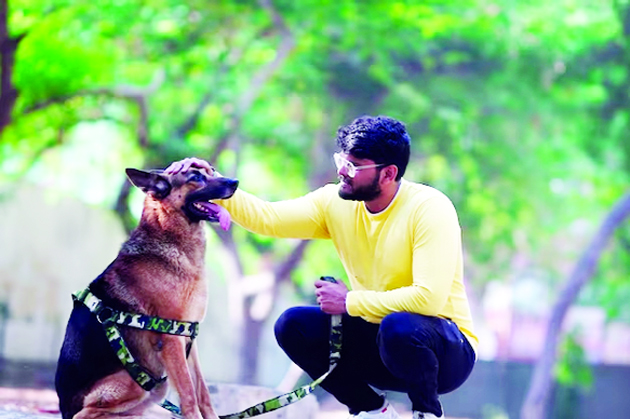Pets: The much required interface of human’s many needs

By Colonel Satish Singh Lalotra
‘Until one has loved an animal, a part of one’s soul remains unawakened’—Anatole France.
The history of ‘Homo sapiens’-the first erect walking human beings on the terra firma of this planet has been inalienably linked to his need to survive amongst a plethora of challenges besetting him ; that ranged from protection from the elements of weather , the wild animals, and maintaining his image of a solid ‘Hunter -gatherer’. In order to sustain his last image the man has been dependent over the last hundred thousand years on our four-legged best friends that have served mankind as its loyalist companions. Right from the ‘Hunter-gatherer’ phase of our ancestors, pooches have evolved alongside humans and are recorded amongst the first animal species that we domesticated. Britishers brought ship loads of diverse pedigreed breeds to the Indian shores to accompany them oceans away from their native soil. Their fancy was jointly imitated by the Rajas, Maharajas and the Nawabs. The dictionary meaning of a pet does not necessarily revolve around the pooches only. The world over, various thesauruses have defined a pet as-‘A companion animal kept primarily for a person’s company or entertainment rather than as a working animal, livestock or a laboratory animal’. Under this broad definition a pet could be a cat, dog, rabbits, ferrets, rodents such as gerbils, hamsters etc. The avian variety such as parrots, Macaws, hawks etc too fall under the category of pets. In fact the highlanders of central Asia comprising the nationalities of Kazakhstan, Kirgizstan, Mongolia, Uzbekistan etc have been for centuries keeping hawks / eagles for hunting in the glacial lands of Pamir knot.
The world famous ‘Maslow’s ‘Hierarchy of needs’ theory which has been in vogue for decades compartmentalizes a human being’s need beginning from ‘physiological’ ( basic survival) need going up in a pyramidal form with ‘Love and belonging’ needs & ‘self-esteem’ need ; that identifies the special relationship between a man and his pet. It is this special bonding between a pet and the so called ‘Pet parent’ or the owner which falls under the ambit of the above mentioned needs that has to be understood in its entirety and acted upon too. Initially, aristocrats kept dogs for both companionship and hunting which slowly transformed into a sign of elitism within the society. By the 19th century, the rise of the middle class stimulated the development of pet keeping and it became inscribed within the bourgeois culture. There’s a reason dogs are dubbed man’s best friend. Dogs –and cats too -make wonderful companions and provide many emotional and physical benefits. ‘Hachiko'( 10 november 1923 -08 th March 1935) was a Japanese ‘Akita dog’ remembered for his remarkable loyalty to his master /owner, ‘Hidesaburo Ueno’ for whom he continued to wait for over 9 years following Ueno’s death. During his life time ‘Hachiko’ the dog, was held up in Japanese culture as an example of loyalty and fidelity. Since his death he continues to be remembered worldwide in popular culture with statues, movies and books.
Though there are dime a dozen health benefits that accrue out of keeping a pet in the household, the most obvious benefits of pet ownership are love and companionship as has been mentioned by me in this write up. We do best medically and emotionally when we feel securely attached to another, because we are mammals and that’s the way we have evolved. We feel especially secure with dogs and cats because of the unconditional love they provide. No matter what you do or say, your dog or cat accepts you and is attached to you. Taking care of a dog or a cat can provide a sense of purpose and a feeling of validation when you wake up or come home and there’s someone who’s happy to see you. The emotional benefits of having a pet can translate into physiological ones too as well. When you feel securely attached to this living being, there are biological brain effects that reduce stress responses, so it may affect your breathing rate or blood pressure or oxygen consumption or anxiety level. There was even a recent study in the journal ‘Science’ about how oxytocin is boosted in both the dog and the human when a dog owner stares into the eyes of the pet or dog. That is really fascinating study and the findings are truly revolutionary. Oxytocin is one of the body’s ‘Feel good’ chemicals and also plays a role in social bonding. Other physical benefits of owning a pet or a dog / cat come from the activity necessary to take care of the animal such as playing or taking it for a walk. And there can be social benefits of pet walking if you meet other people along the way. A true interface of societal behaviuor.
It’s not always easy to take care for pets, however, and sometimes having them in the home poses health hazards for older adults. If you have problems with allergy to pollen grains, animal furs, or even their smell it can be a real nasty experience to live with such a pet in the house. If you have a problem with gait and stability and your pet can get under your feet or jump and knock you over, then falls and broken bones are an everyday affair making you take numerous rounds of orthopedics. There are sanitary issues too associated with the pets and its ownership. Animals can carry parasites called as ‘Toxoplasma gondii’ which can get into your brain and cause a condition known as ‘Toxoplasmosis’. People with compromised immune systems are especially vulnerable to this problem. Animal feces carry all kinds of bacteria that can make you sick. Dogs and cats can also trigger allergic reactions in some of the owners. With the rising disposable income across the cross sections of the society , it has now become a fashion statement to own a pet or a pooch ( dog) with the icing on the cake resting on that small wooden or iron hanging plate outside the gate of the house with words to the effect-‘BEWARE OF THE DOG’. This small statement is enough for an outsider or a bystander to know as to which strata of society the house owner belongs to.
Before getting into the mode of a pet parent or a pet owner, consider if you are physically and mentally capable to take care of the intended pet, or is this craving only a figment of your imagination fired by a quirky chance encounter with a pet owner whom you secretly admire and follow in his or her footsteps? If it is the latter response then be a little pragmatic in your approach to pet keeping and try distancing with this thought of yours. Pet keeping not only requires endless rounds to a vet for routine health checkup and mandatory vaccination but also adequate financial backup to bear the brunt of such an activity.
The US bureau of labour statistics reports the average pet owner spending about $ 500 per year (about INR 45,000). Does an Indian pet parent or owner has that much of magnanimity to loosen his purse strings for the upkeep of his pet? I have my very serious doubts about this issue of being a spendthrift when it comes to pet caring in India. Leave alone pet caring, a pet owner has to be very careful with his pet-upbringing in a metro city which is nowadays dotted with sky scrapers. With a burgeoning population living choc-a-bloc in such sky scrapers there have been instances where the pets have inadvertently crossed the behavioural limits (being an animal) and infringed upon the physical and mental territory of a neighbour resulting in many a times to scuffles and even shooting incidents. In such a scenario the pet owners ought to be very well versed with the latest rules and regulations governing pet care and the remedies enshrined in these AWBI (Animal welfare board of India) lest they repent their decision of being a pet owner at leisure.
It would be a travesty of justice to this article of mine as well as the readers, if I don’t mention the idiosyncrasies of some of our past Rajas, Maharajas and Nawabs when it came to pet care and ownership. Indian royals and their passion for the 4 -legged family members is no less than an illustrious affair. From regal grooming to opulent weddings, their canines lived a life of luxury. With the establishment of so called ‘Kennel clubs’ all over the imperial India , including the respective kennel clubs of Hyderabad, Ootacamund, Mysore, Calcutta to name a few , the royals of India went into a headlong rush to own some of the most bizarre and exotic varieties of dogs. In her epic essay-‘Passion Royale for pampering pets’ Roshini Johar gives a fascinating account of the eccentricities involved in regal pet grooming. The last Nawab of Junagadh before partition of India also known by the name -Nawab Muhammed Mahabat Khanji -III owned 800 dogs , each with its own room , a telephone and a servant. A white tiled hospital with a British vet attended to their ailments.
When a dog died, Chopin’s funeral march was played and a state mourning declared. To annoy the Raj whose airs and graces he resented, the Nawab of Junagadh had his liveried staff dress his dogs in formal evening suits, mount them on rickshaws and drive them on British summer capital Shimla’s fashionable Mall road. The same Nawab later on invited Lord Irwin the then viceroy to grace the occasion of marriage of ‘ROSHANARA’ the pet dog of his with ‘Bobby’ a royal golden retriever belonging to the Nawab of Mangrol . It is in recorded history that this Nawab of Junagadh was hand in glove with Pakistan to get his estate’s accession done with that country, which was ably foiled by the Iron man of India ( Sardar Patel) in 1948. The Nawab fled to Karachi ,Pakistan in an aircraft but not before boarding all his pet dogs with him in the plane. Even the Maharaja of Patiala Bhupinder singh was not far away in such eccentrics. Amongst the contemporary Rajput community of Rajasthan one would find very few houses without the presence of the family pooch. Be it the Jodhpur fox terriers, Axle -the Ajirapura Doberman, Zara – the Gamph Alsatian, Rajkot’s harlequin great Dane etc each one of them descended from a diverse culture of hound-domestication and dog- loving.
As the most widespread and probably the oldest companion of a man (Homo sapiens) from his cave man days, the dog has lived up to its title -‘A man’s best friend’ and also his best interface among his myriad needs.



